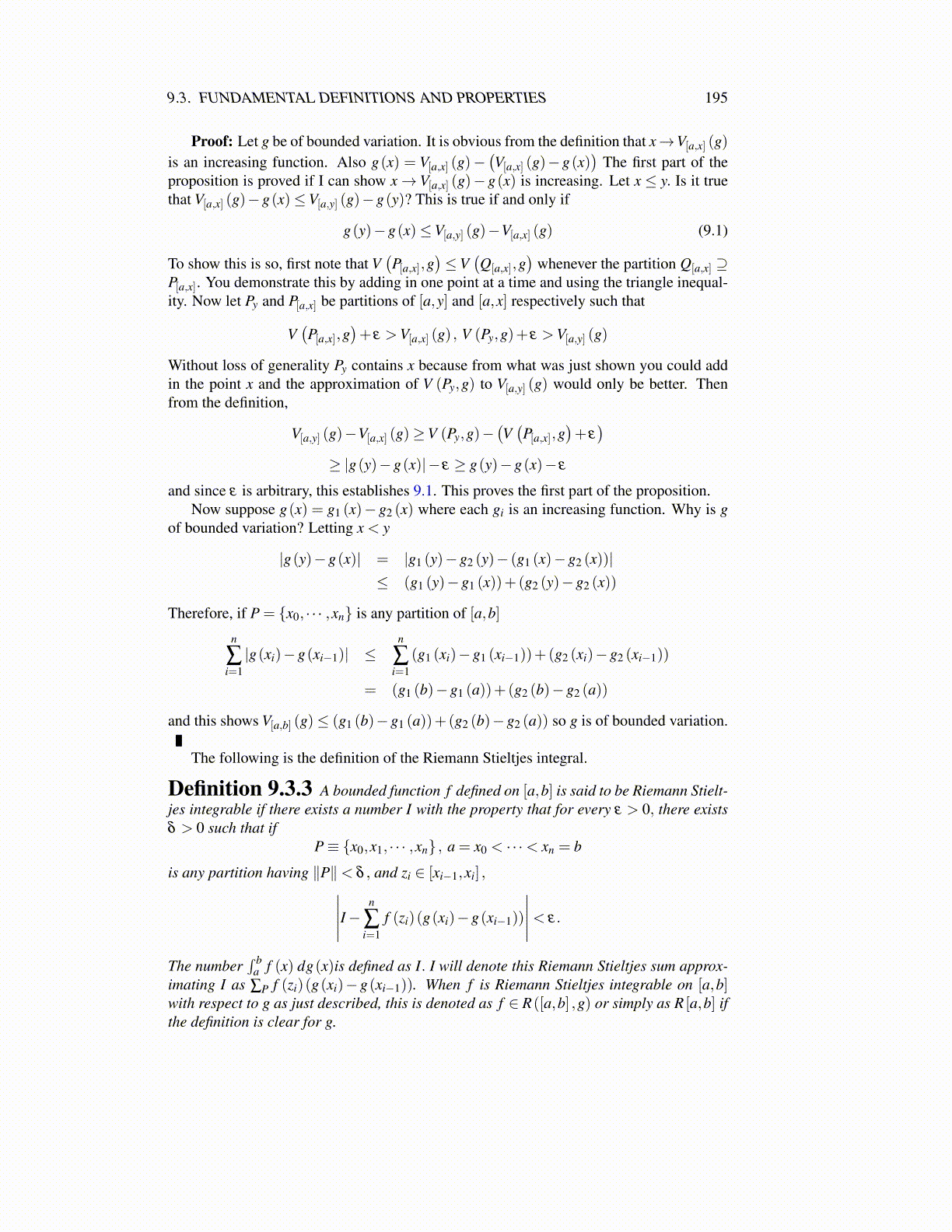
9.3. FUNDAMENTAL DEFINITIONS AND PROPERTIES 195
and since ε is arbitrary, this shows that the expression inside |·| equals 0.If g is increasing, then the Riemann sums are all nonnegative if f ≥ 0. Thus∫ b
a(| f |− f )dg,
∫ b
a(| f |+ f )dg≥ 0
and so ∫ b
a| f |dg≥max
(∫ b
af dg,−
∫ b
af dg),∫ b
a| f |dg≥
∣∣∣∣∫ b
af dg∣∣∣∣
For the last claim, let δ > 0 be such that when ∥P∥< δ , all integrals are approximatedwithin ε be a Riemann sum based on P. Without loss of generality, letting PI be such apartition for I each of the intervals needed, we can assume P[a,b] contains c since adding itin will not increase ∥P∥. Also we can let each of the other two PI be the restriction of P[a,b]to [a,c] or [c,b]. Then∣∣∣∣∫ c
af dg−SP[a,c] ( f )
∣∣∣∣< ε,
∣∣∣∣∫ b
cf dg−SP[c,b]
∣∣∣∣< ε,
∣∣∣∣∫ b
af dg−SP[a,b]
∣∣∣∣< ε
we can also pick the same intermediate point in each of these sums. Then SP[a,b] = SP[a,c] +
SP[c,b] and so, from the triangle inequality,∣∣∣∫ b
a f dg−(∫ c
a f dg+∫ b
c f dg)∣∣∣< 3ε and since ε
is arbitrary, the desired relation follows.When does the integral make sense? The main result is the next theorem. We have in
mind the case where f and g have real values but there is no change in the argument ifthey have complex values or even more general situations such as where g has values in acomplete normed linear space and f has scalar values or when f has values in a normedlinear space and g has scalar values or even more general situations. You simply changethe meaning of the symbols used in the following argument. This is why I am being vagueabout where f and g have their values.
Theorem 9.3.7 Let f be continuous on [a,b] and let g be of finite total varia-tion on [a,b]. Then f is Riemann Stieltjes integrable in the sense of Definition 9.3.3,f ∈ R([a,b] ,g) .
Proof: Since f is continuous and [a,b] is sequentially compact, it follows from Theo-rem 6.7.2 that f is uniformly continuous. Thus if ε > 0 is given, there exists δ > 0 suchthat if |x− y|< δ , then
| f (x)− f (y)|< ε
2(V[a,b] (g)+1
) .Let P = {x0, · · · ,xn} be a partition such that ||P|| < δ . Now if you add in a point z on theinterior of I j and consider the new partition,
x0 < · · ·< x j−1 < z < x j < · · ·< xn
denoting it by P′,
S (P, f )−S(P′, f
)=
j−1
∑i=1
(f (ti)− f
(t ′i))
(g(xi)−g(xi−1))
+ f (t j)(g(x j)−g
(x j−1
))− f
(t ′j)(
g(z)−g(x j−1
))